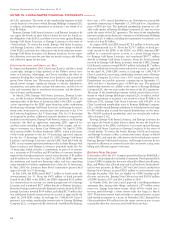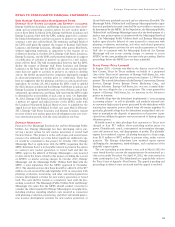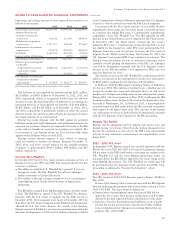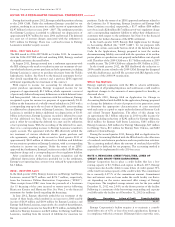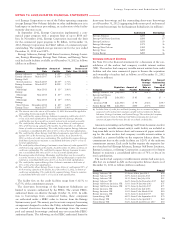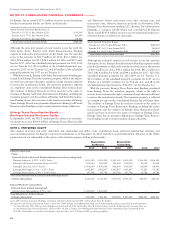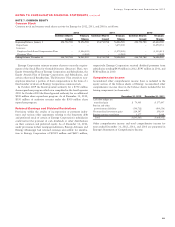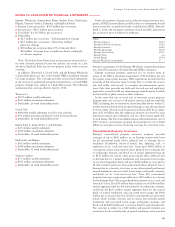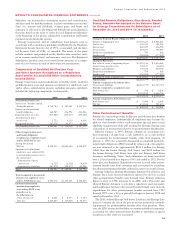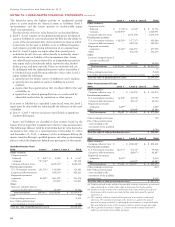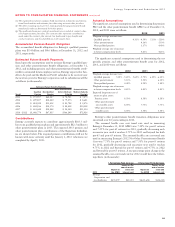Entergy 2012 Annual Report Download - page 86
Download and view the complete annual report
Please find page 86 of the 2012 Entergy annual report below. You can navigate through the pages in the report by either clicking on the pages listed below, or by using the keyword search tool below to find specific information within the annual report.Entergy Corporation and Subsidiaries 2012
NOTES TO CONSOLIDATED FINANCIAL STATEMENTS continued
NOTE 8. COMMITMENTS AND CONTINGENCIES
Entergy and the Registrant Subsidiaries are involved in a number of
legal, regulatory, and tax proceedings before various courts, regula-
tory commissions, and governmental agencies in the ordinary course
of business. While management is unable to predict the outcome of
such proceedings, management does not believe that the ultimate
resolution of these matters will have a material effect on Entergy’s
results of operations, cash flows, or financial condition. Entergy dis-
cusses regulatory proceedings in Note 2 to the financial statements
and discusses tax proceedings in Note 3 to the financial statements.
Vidalia Purchased Power Agreement
Entergy Louisiana has an agreement extending through the year 2031
to purchase energy generated by a hydroelectric facility known as the
Vidalia project. Entergy Louisiana made payments under the contract
of approximately $125.0 million in 2012, $185.6 million in 2011,
and $216.5 million in 2010. If the maximum percentage (94%) of
the energy is made available to Entergy Louisiana, current produc-
tion projections would require estimated payments of approximately
$174.9 million in 2013, and a total of $2.37 billion for the years
2014 through 2031. Entergy Louisiana currently recovers the costs of
the purchased energy through its fuel adjustment clause.
In an LPSC-approved settlement related to tax benefits from the
tax treatment of the Vidalia contract, Entergy Louisiana agreed to
credit rates by $11 million each year for up to ten years, beginning in
October 2002. In addition, in accordance with an LPSC settlement,
Entergy Louisiana credited rates in August 2007 by $11.3 million
(including interest) as a result of a settlement with the IRS of the 2001
tax treatment of the Vidalia contract. As discussed in more detail in
Note 3 to the financial statements, in August 2011, Entergy agreed
to a settlement with the IRS regarding the mark-to-market income
tax treatment of various wholesale electric power purchase and sale
agreements, including the Vidalia agreement. In October 2011, the
LPSC approved a final settlement under which Entergy Louisiana
agreed to share the remaining benefits of this tax accounting election
by crediting customers an additional $20.235 million per year for 15
years beginning January 2012. Entergy Louisiana recorded a $199
million regulatory charge and a corresponding net-of-tax regulatory
liability to reflect this obligation. The provisions of the settlement also
provide that the LPSC shall not recognize or use Entergy Louisiana’s
use of the cash benefits from the tax treatment in setting any of Entergy
Louisiana’s rates. Therefore, to the extent Entergy Louisiana’s use of
the proceeds would ordinarily have reduced its rate base, no change in
rate base shall be reflected for ratemaking purposes.
Nuclear Insurance
THIRD PARTY LIABILITY INSURANCE
The Price-Anderson Act requires that reactor licensees purchase
insurance and participate in a secondary insurance pool that provides
insurance coverage for the public in the event of a nuclear power
plant accident. The costs of this insurance are borne by the nuclear
power industry. Congress amended and renewed the Price-Ander-
son Act in 2005 for a term through 2025. The Price-Anderson Act
requires nuclear power plants to show evidence of financial protec-
tion in the event of a nuclear accident. This protection must consist
of two layers of coverage:
1. The primary level is private insurance underwritten by American
Nuclear Insurers (ANI) and provides public liability insurance
coverage of $375 million. If this amount is not sufficient to cover
claims arising from an accident, the second level, Secondary
Financial Protection, applies.
2. Within the Secondary Financial Protection level, each nuclear
reactor has a contingent obligation to pay a retrospective pre-
mium, equal to its proportionate share of the loss in excess of
the primary level, regardless of proximity to the incident or fault,
up to a maximum of $117.5 million per reactor per incident
(Entergy’s maximum total contingent obligation per incident is
$1.3 billion). This consists of a $111.9 million maximum retro-
spective premium plus a five percent surcharge, which equates
to $117.5 million, that may be payable, if needed, at a rate that
is currently set at $17.5 million per year per incident per nuclear
power reactor.
3. In the event that one or more acts of terrorism cause a nuclear
power plant accident, which results in third-party damages – off-
site property and environmental damage, off-site bodily injury,
and on-site third-party bodily injury (i.e. contractors); the pri-
mary level provided by ANI combined with the Secondary Finan-
cial Protection would provide $12.6 billion in coverage. The
Terrorism Risk Insurance Reauthorization Act of 2007 created a
government program that provides for up to $100 billion in cov-
erage in excess of existing coverage for a terrorist event.
Currently, 104 nuclear reactors are participating in the Second-
ary Financial Protection program. The product of the maximum ret-
rospective premium assessment to the nuclear power industry and
the number of nuclear power reactors provides over $12.2 billion in
secondary layer insurance coverage to compensate the public in the
event of a nuclear power reactor accident. The Price-Anderson Act
provides that all potential liability for a nuclear accident is limited to
the amounts of insurance coverage available under the primary and
secondary layers.
Entergy Arkansas has two licensed reactors and Entergy Gulf
States Louisiana, Entergy Louisiana, and System Energy each have
one licensed reactor (10% of Grand Gulf is owned by a non-affil-
iated company (SMEPA) that would share on a pro-rata basis in
any retrospective premium assessment to System Energy under the
Price-Anderson Act). The Entergy Wholesale Commodities segment
includes the ownership and operation of six nuclear power reactors
and the ownership of the shutdown Indian Point 1 reactor and Big
Rock Point facility.
PROPERTY INSURANCE
Entergy’s nuclear owner/licensee subsidiaries are members of Nuclear
Electric Insurance Limited (NEIL), a mutual insurance company that
provides property damage coverage, including decontamination and
premature decommissioning expense, to the members’ nuclear gen-
erating plants. Effective April 1, 2012, Entergy was insured against
such losses per the following structures:
Utility Plants (ANO 1 and 2, Grand Gulf, River Bend, and
Waterford 3)
n Primary Layer (per plant) - $500 million per occurrence
n Excess Layer (per plant) - $750 million per occurrence
n Blanket Layer (shared among the Utility plants) - $350 million
per occurrence
n Total limit - $1.6 billion per occurrence
n Deductibles:
n $2.5 million per occurrence - Turbine/generator damage
n $2.5 million per occurrence - Other than turbine/
generator damage
n $10 million per occurrence plus 10% of amount above
$10 million - Damage from a windstorm, flood, earthquake,
or volcanic eruption
Note: ANO 1 and 2 share in the primary and excess layers with
common policies because the policies are issued on a per site basis.
84


